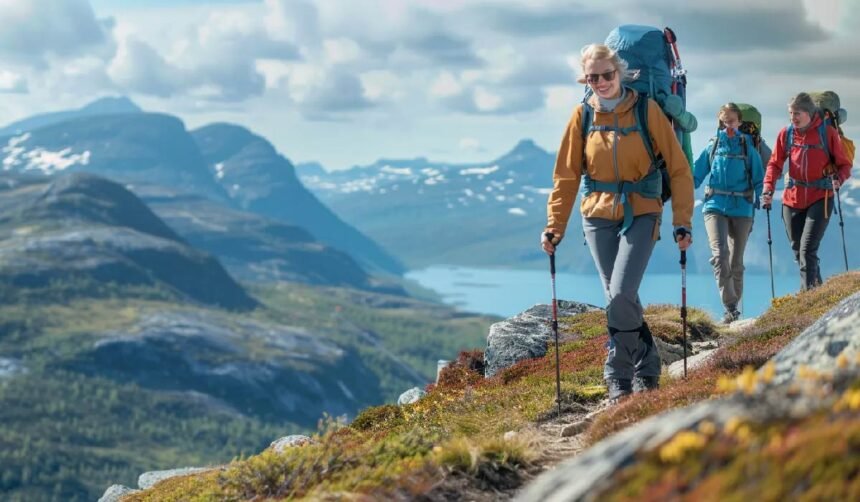Alaska offers some of the most breathtaking and rugged wilderness on the planet. For backpackers, it represents a true adventure—a chance to disconnect and immerse yourself in landscapes filled with towering glaciers, vast tundra, and abundant wildlife. The sheer scale of Alaska’s beauty is matched only by its challenges, making a multi-day trek here a rewarding experience unlike any other.
Planning Your Alaskan Backpacking Adventure
A successful backpacking trip in Alaska requires careful planning. The weather can change in an instant, wildlife encounters are common, and many of the best trails are remote. Before you set out, you need to consider a few key factors to ensure your trip is both safe and enjoyable.
- Permits and Regulations: Many of Alaska’s prime backpacking destinations are within national parks or preserves, which often require permits for overnight trips. These permits help manage visitor numbers and protect the fragile ecosystem. Always check the specific requirements for the area you plan to visit well in advance, as some permits are issued through lotteries months ahead of time.
- Weather Conditions: Alaskan weather is notoriously unpredictable. Even in the summer, you can experience sun, rain, wind, and even snow in a single day. Pack layers of waterproof and insulating clothing, and always check the forecast right before you depart. Being prepared for the worst-case scenario is essential.
- Wildlife Encounters: Alaska is home to bears, moose, wolves, and other large animals. Knowing how to act during an encounter is critical for your safety and their well-being. Carry bear spray, know how to use it, and store your food in bear-resistant containers.
Kesugi Ridge Trail
For those seeking classic Alaskan scenery without extreme remoteness, the Kesugi Ridge Trail in Denali State Park is an excellent choice. This trail offers consistent, stunning views of the Alaska Range, including Denali, North America’s tallest peak.
- Difficulty: Moderate to difficult. The trail involves significant elevation gain and can be strenuous, especially with a full pack.
- Length: 27-36 miles, typically completed in 2-4 days. The length depends on your chosen start and end points (Little Coal Creek, Byers Lake, or Troublesome Creek trailheads).
- Highlights: The main draw is the non-stop panoramic view of Denali and the surrounding peaks. You’ll hike through alpine tundra dotted with wildflowers, cross small streams, and have opportunities to spot wildlife like caribou and Dall sheep. Because it’s a well-defined trail, it’s a more accessible option for experienced backpackers who are new to Alaska.
The Chilkoot Trail
Step back in time and follow the path of Klondike Gold Rush prospectors on the historic Chilkoot Trail. This route, co-managed by the U.S. National Park Service and Parks Canada, stretches from Dyea, Alaska, to Bennett, British Columbia, offering a unique blend of history and natural beauty.
- Difficulty: The trail is physically demanding, particularly the steep, rocky ascent over Chilkoot Pass, known as the “Golden Stairs.”
- Length: 33 miles, typically completed in 3-5 days. The international border crossing and historical significance make this a trek worth taking your time on.
- Highlights: The trail is an open-air museum, scattered with artifacts left behind by the stampeders of 1898. You’ll traverse diverse ecosystems, from coastal rainforest to alpine tundra and boreal forest. The sense of accomplishment after conquering the pass is a major highlight, as is reaching the pristine, glacier-fed Lake Bennett.
Katmai National Park Traverse
For the truly adventurous backpacker seeking a wild, off-trail experience, a traverse through Katmai National Park is a trip of a lifetime. This route is not a marked trail but a cross-country journey through the Valley of Ten Thousand Smokes, a landscape shaped by one of the 20th century’s largest volcanic eruptions.
- Difficulty: Very difficult. This trip requires excellent navigation skills, experience with river crossings, and complete self-sufficiency. There are no marked paths or facilities.
- Length: Approximately 30-40 miles, typically completed in 4-6 days. The route usually runs from the Brooks River area to the Katmai coast or vice versa.
- Highlights: The scenery is otherworldly. You’ll hike across a vast expanse of ash and pumice, explore deep river canyons, and witness the land slowly recovering from the 1912 Novarupta eruption. Katmai is also famous for its dense population of brown bears, and you are almost guaranteed to see them (from a safe distance, of course). This trek offers a profound sense of solitude and connection with raw nature. Due to its remote location, many visitors fly in and stay at one of the hotels in King Salmon, Alaska, before or after their trip.
Essential Backpacking Gear for Alaska
Packing the right gear is crucial for a safe and comfortable trip. This is not the place to cut corners.
- Shelter: A sturdy, waterproof, three-season tent with a full-coverage rainfly.
- Sleeping System: A warm sleeping bag (rated to at least 15-20°F) and an insulated sleeping pad.
- Clothing: Layering is key. Include a waterproof rain jacket and pants, an insulating puffy jacket, fleece layers, and moisture-wicking base layers. Avoid cotton.
- Footwear: Broken-in, waterproof hiking boots with good ankle support.
- Navigation: Map and compass are essential, even if you have a GPS device or phone.
- Bear Safety: Bear spray (one per person) and a bear-resistant food canister.
- Water Treatment: A reliable filter or purification system.
- First-Aid Kit: A comprehensive kit tailored to backcountry injuries.
- Trekking Poles: Highly recommended for stability on uneven terrain and during river crossings.
Conclusion
Backpacking in Alaska is an opportunity to explore some of the last truly wild places in North America. The routes described here—Kesugi Ridge, the Chilkoot Trail, and a Katmai traverse—offer three distinct yet equally incredible experiences. Each requires preparation, respect for the environment, and a spirit of adventure.







